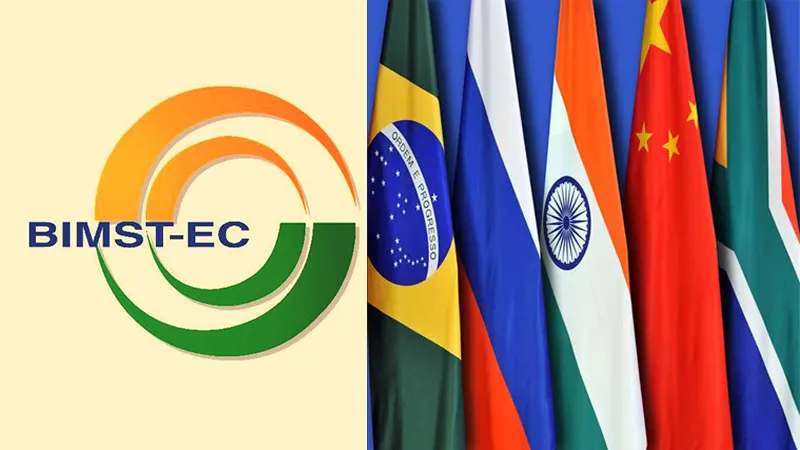
As leaders of BIMSTEC (Bay of Bengal Initiative for Multi-Sectoral Technical and Economic Cooperation) meet leaders of BRICS (Brazil, Russia, India, China and South Africa) in Goa as part of the latter’s outreach summit next week, in many ways it indicates New Delhi’s shifting regional diplomatic focus and gives BIMSTEC its most high-profile global exposure since its inception. BIMSTEC was established almost two decades ago by few countries from South Asia and Southeast Asia to reconnect and reintegrate the two regions.
Until now, BIMSTEC as a forum has barely engaged regional and global institutions. The only noteworthy collaboration it has is with Asian Development Bank (ADB) which became a development partner of the forum since 2005. With connectivity being a major objective of the sub-regional forum, ADB has undertaken a study to help promote and improve transport infrastructure and logistic among the BIMSTEC countries.
Various factors explain New Delhi’s decision to invite BIMSTEC leaders to the BRICS outreach summit. First, amid New Delhi’s efforts to isolate Islamabad, inviting SAARC (South Asian Association for Regional Cooperation) leaders would have defeated the purpose. Much has changed in India’s regional diplomacy since Prime Minister Narendra Modi invited SAARC leaders to his swearing-in ceremony a couple of years ago. Second, while Delhi has the option of inviting leaders of the sub-regional BBIN (Bangladesh, Bhutan, India, Nepal) initiative, this would have left out other neighbours including Sri Lanka and Myanmar.
Third, Delhi could have also looked further east and invited leaders from the Mekong countries under the auspices of Mekong-Ganga Cooperation (MGC) or even the nations of ASEAN (Association of Southeast Asian Nations) under India-ASEAN partnership. However, then questions could be raised as to why New Delhi overlooked its immediate neighbours. Moreover, India-ASEAN partnership and the MGC are forums involving only India and Southeast Asian nations without membership from other South Asian nations.
The unique position of the seven-member BIMSTEC presents itself fittingly in New Delhi’s current diplomatic interest. The strategic salience of the BIMSTEC forum for India can be ascertained when seen through India’s sub-regions. The BIMSTEC connects three important sub-regions of India — Nepal and Bhutan in the Himalayan sub-region; Sri Lanka and Bangladesh in the Bay of Bengal sub-region; and Myanmar and Thailand in the Mekong sub-region. BIMSTEC is the only forum that brings together India’s strategic peripheries (South, East and North) under one single grouping. Furthermore, it also keeps geopolitical concerns at bay as regional players such as China and Pakistan are not members of BIMSTEC.
The BIMSTEC is also at the centre of New Delhi’s engagements with other various regional and sub-regional groupings in India’s eastern neighbourhood with its members often are also members of other regional and sub-regional groupings in their respective regions and sub-regions. For instance, Myanmar and Thailand are members of ASEAN and Greater Mekong Subregion (GMS) while Bangladesh, Bhutan and Nepal are members of SAARC and BBIN. Bangladesh and Myanmar are also members of the four-member sub-regional BCIM (Bangladesh, China, India, Myanmar) forum along with India and China. The progress of BIMSTEC, therefore, could help regional integration of the entire north-eastern Indian Ocean region with the Bay of Bengal at the centre.
Inviting BIMSTEC leaders to the BRICS Summit also subtly demonstrates that the sub-regions represented in the BIMSTEC form India’s traditional backward where its primacy should to be respected. India’s strategic interests in these sub-regions have been growing over the recent years both as a result of India’s own domestic interests as well as because of enhanced Chinese influence and presence in these geo-strategic sub-regions. The China factor has emerged as a major area of geopolitical concern in India’s engagements with the nations in these sub-regions.
Even as India and China have not engaged in direct military confrontation for decades since their border conflict in 1962, their strategic competition has been increasingly shaping the regional dynamics of the BIMSTEC region. China is a key member in BRICS. It would be interesting to see how India and China view their roles in the BIMSTEC theatre. While engaging BIMSTEC in BRICS outreach provides an opportunity for the two Asian giants to work together in a sub-region where both have overlapping strategic interests, strategic mistrust and Beijing’s ties with Islamabad would remain a roadblock in building a common vision for the BIMSTEC region.
Islamabad’s unwillingness to be part of regional cooperation where India is involved was clearly demonstrated with its opposition to a SAARC motor vehicle agreement. The prospect for bilateral and regional cooperation along India’s western border remains limited with cold ties setting in again between India and Pakistan. Delhi’s strategic spaces to manoeuvre and its ability to take its regional diplomacy to a new level, particularly the ‘Act East’ policy will largely depend on its engagements with its eastern neighbourhood. BIMSTEC along with other regional and sub-regional forums where India is a member are platforms to achieve these objectives.
The Modi administration has struck the right diplomatic note with its BRICS-BIMSTEC outreach summit. New Delhi and BIMSTEC need to seek greater synergy in regional development and security. The BIMSTEC region remains one of the least integrated regions in the world. Some recent positive developments in the region could be further expanded to the BIMSTEC. India, Myanmar and Thailand have already begun talk on free movement of vehicles similar to the BBIN motor vehicles agreement. Such an initiative will cover most of BIMSTEC nations except Sri Lanka. With several bilateral and multilateral agreements between and among BIMSTEC nations already in place in trade, investment, connectivity in energy, road, rail, digital and pipelines, the logical step would be to expand them at the BIMSTEC level.
India has a trilateral maritime security initiative with Sri Lanka and Maldives that aims to enhance maritime security in the Indian Ocean. Five BIMSTEC nations form key littorals of the Bay of Bengal. As all the BIMSTEC nations increasingly turn to the Bay’s resources for economic development, New Delhi could propose a similar maritime security initiative with the BIMSTEC nations for mutual maritime security in the Bay.
The views expressed above belong to the author(s). ORF research and analyses now available on Telegram! Click here to access our curated content — blogs, longforms and interviews.




 PREV
PREV


